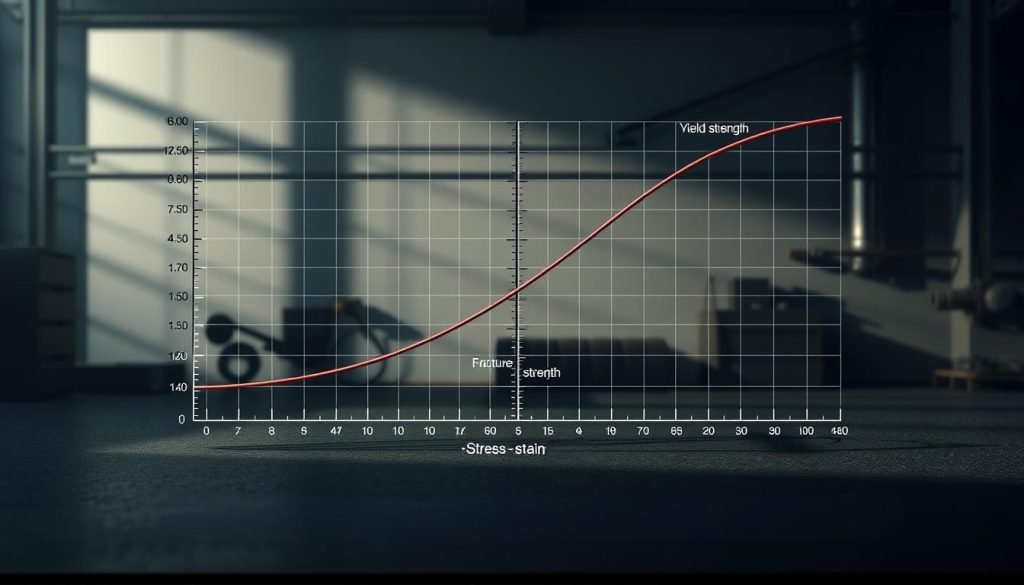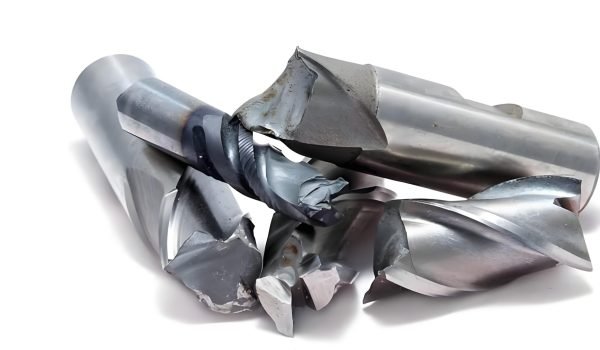Did you know that nearly 80% of material failures in engineering applications are due to tensile stress? This staggering statistic highlights the importance of understanding a material’s maximum stress it can withstand before breaking. Ultimate Tensile Strength (UTS) is a critical property that measures this resistance.
UTS represents the maximum stress a material can handle while being stretched or pulled before failing. This property is crucial for engineers and designers to select the right materials for their projects, ensuring structural integrity and safety.
Understanding Ultimate Tensile Strength: Basic Concepts

To grasp the concept of ultimate tensile strength, you need to understand its fundamental principles. Ultimate tensile strength is a measure of a material’s ability to withstand tensile forces.
Definition of Ultimate Tensile Strength
Ultimate tensile strength refers to the maximum stress a material can withstand while being stretched or pulled before failing or breaking. This property is crucial in determining the suitability of a material for a particular application. The ultimate tensile strength of a material is typically determined through a tensile test, where a sample is subjected to increasing tension until it fractures.
Units of Measurement for Ultimate Tensile Strength
The units used to measure ultimate tensile strength are typically force per unit area. In the International System of Units (SI), the unit is the pascal (Pa) or megapascals (MPa). In the United States, pounds per square inch (psi) is commonly used.
The relationship between these units is straightforward: 1 MPa equals approximately 145 psi. Material datasheets often report ultimate tensile strength in both MPa and psi to accommodate global engineering practices. Misinterpreting these units can lead to design failures, emphasizing the importance of understanding the units used to measure ultimate tensile strength.
The Science Behind Ultimate Tensile Strength
To comprehend ultimate tensile strength, one must first grasp the fundamental principles governing material deformation. This understanding is crucial for predicting how materials will behave under various loading conditions.
Stress-Strain Relationship

The stress-strain relationship is a graphical representation of how a material responds to external forces. As stress is applied, the material deforms, and the resulting strain is measured. This relationship is critical in determining a material’s ultimate tensile strength.
Elastic vs. Plastic Deformation
Material deformation can be categorized into elastic and plastic deformation. Elastic deformation occurs when a material returns to its original shape after the removal of an applied stress, governed by Hooke’s Law. In contrast, plastic deformation refers to the permanent change in a material’s shape after the applied stress exceeds the yield strength. Understanding the transition from elastic to plastic deformation is vital for engineers, as it defines the operational limits for materials in various applications.
You should note that the ability of a material to undergo significant plastic deformation before breaking is a measure of its ductility. The extent of plastic deformation before reaching ultimate tensile strength provides valuable information about a material’s toughness and ability to absorb energy before catastrophic failure.
How Ultimate Tensile Strength Works in Materials
As you explore the properties of materials, you’ll find that ultimate tensile strength is a key factor in their characterization. This property is crucial in understanding how different materials behave when subjected to tensile forces.
Molecular and Structural Basis
The ultimate tensile strength of a material is influenced by its molecular and structural composition. When tension is applied, materials initially respond elastically, with atoms or molecules shifting slightly from their equilibrium positions. The material’s ability to withstand deformation depends on its internal structure and the bonds between its atoms or molecules.
Material Behavior Under Tension
Different materials exhibit distinct behaviors under tensile stress. Ductile materials, such as metals, can undergo significant plastic deformation before fracture, while brittle materials, like ceramics, tend to fracture suddenly without warning. The behavior of a material under tension is critical in determining its suitability for various applications, from automotive components to structural elements.
Understanding these behaviors is essential for selecting the right materials for specific uses and ensuring the safety and durability of the final product.
The Significance of Ultimate Tensile Strength in Engineering
In engineering, the ultimate tensile strength is a key property that influences both material selection and design considerations. You need to understand how this property affects the overall performance and safety of structures and components.
Role in Material Selection
When selecting materials for a specific application, you must consider various factors, including load-bearing capacity, operating temperature, and environmental conditions. The ultimate tensile strength is crucial in determining a material’s ability to withstand stress without failing. For instance, components exposed to high temperatures or corrosive environments require materials with specific properties to ensure durability and reliability.
You should match the material’s yield strength and tensile strength to the anticipated loads and stresses during its service life. This ensures that the component can perform as expected without catastrophic failure.
Impact on Design and Safety Factors
The ultimate tensile strength directly influences critical design parameters, such as minimum cross-sectional areas and wall thicknesses, to ensure that structures can withstand expected loads. You incorporate safety factors into designs by dividing the ultimate tensile strength by an appropriate factor, typically between 1.5 and 4, to account for unexpected loads or material variations.
Regulatory requirements often specify minimum safety factors based on ultimate tensile strength for critical applications, such as aerospace or civil infrastructure, to ensure public safety. Additionally, the difference between yield strength and ultimate tensile strength provides valuable information about a material’s capacity to absorb energy before failure.
Calculating Ultimate Tensile Strength
The process of calculating ultimate tensile strength involves a combination of experimental testing and mathematical analysis. You need to understand both aspects to accurately determine a material’s tensile strength.
Testing Methods and Equipment
To calculate ultimate tensile strength, you must conduct tensile tests using specialized equipment. This equipment applies a force to a specimen until it fractures, measuring the maximum force applied. The test results provide data on the material’s stress-strain relationship.
Mathematical Formulas and Calculations
The fundamental formula for calculating ultimate tensile strength (UTS) is UTS = Fmax/A0, where Fmax is the maximum force applied before fracture and A0 is the original cross-sectional area. This yields engineering stress values typically expressed in MPa or psi. For more precise analysis, true stress calculations account for the changing cross-sectional area during testing. You can also use the formula σtrue = σeng(1+εeng) to relate engineering stress and true s
Ultimate Tensile Strength vs. Yield Strength
In engineering, the concepts of ultimate tensile strength and yield strength are fundamental to designing safe and functional parts. Both properties are crucial in understanding a material’s behavior under stress, but they serve different purposes in the design process.
Key Differences and Relationships
Ultimate tensile strength refers to the maximum stress a material can withstand before failing or breaking, while yield strength indicates the stress at which a material begins to deform plastically. The relationship between these two properties is critical, as it determines a material’s ability to absorb energy and resist deformation.
When to Consider Each Property
You should consider yield strength as the primary design criterion for applications where dimensional stability is critical, such as precision mechanical components. In contrast, ultimate tensile strength is more relevant for brittle materials that exhibit little plastic deformation. For safety-critical applications, both properties must be considered together to ensure safe operation and prevent catastrophic failure.
Factors Affecting Ultimate Tensile Strength
Several factors can significantly impact the ultimate tensile strength of materials, and it’s essential to understand these factors to make informed decisions. The ultimate tensile strength is a critical property that determines a material’s ability to withstand tensile forces without failing.
Material Composition and Structure
The composition and structure of a material play a crucial role in determining its ultimate tensile strength. The arrangement of atoms, molecules, or crystals within the material influences its mechanical properties. For instance, the presence of impurities or defects can weaken a material, while a uniform crystal structure can enhance its strength.
Temperature and Environmental Conditions
Temperature and environmental conditions also significantly affect the ultimate tensile strength of materials. Changes in temperature can alter a material’s mechanical behavior, with some materials becoming more brittle at low temperatures and others losing strength at high temperatures. Environmental factors such as humidity, exposure to chemicals, and radiation can also impact a material’s tensile strength.
Manufacturing Processes and Treatments
Manufacturing processes and treatments can substantially influence the ultimate tensile strength of materials. Heat treatments, such as quenching and tempering, can alter a material’s microstructure, thereby enhancing its strength. Cold working processes like rolling and drawing can increase tensile strength through strain hardening. Surface treatments, including carburizing and shot peening, can create compressive residual stresses that improve tensile strength. Additionally, processes like welding and additive manufacturing introduce unique considerations that must be accounted for in design.
Ultimate Tensile Strength of Common Materials
You need to know the ultimate tensile strength of materials to ensure you’re using the right one for your specific needs. Different materials have varying ultimate tensile strengths, which is a crucial factor in their application.
Metals and Alloys
Metals and alloys exhibit a wide range of ultimate tensile strengths. For instance, some high-strength steel alloys can have ultimate tensile strengths exceeding 2,000 MPa, while certain aluminum alloys may have ultimate tensile strengths around 500 MPa. The ultimate tensile strength of metals is crucial for structural applications.
Polymers and Composites
Polymers and composites also display a broad spectrum of ultimate tensile strengths. For example, carbon fiber reinforced polymers (CFRP) can achieve ultimate tensile strengths of over 1,600 MPa, making them suitable for aerospace applications. In contrast, some polymers may have much lower ultimate tensile strengths, around 50 MPa.
Ceramics and Other Materials
Ceramics typically have low ultimate tensile strengths, often between 10-50 MPa, due to their brittleness. However, advanced ceramics like silicon carbide can achieve higher strengths, up to 300 MPa, through careful processing. Other materials like glass fibers can reach extraordinary ultimate tensile strengths, with S-glass fibers exceeding 4,700 MPa.
Practical Applications of Ultimate Tensile Strength
Ultimate Tensile Strength plays a vital role in the design and development of products across multiple industries. Its significance is reflected in the diverse applications that rely on this fundamental material property.
Aerospace and Automotive Industries
In the aerospace and automotive sectors, Ultimate Tensile Strength is crucial for selecting materials that can withstand various stresses. Lightweight materials with high tensile strength, such as advanced composites, are used to improve fuel efficiency and safety.
Construction and Structural Engineering
In construction and structural engineering, Ultimate Tensile Strength is essential for ensuring the integrity of buildings and bridges. Materials like high-strength steel and fiber-reinforced polymers are chosen based on their tensile properties to guarantee structural stability and durability.
Consumer Products and Manufacturing
In consumer products and manufacturing, understanding Ultimate Tensile Strength enables the creation of durable and reliable goods. For instance, smartphone manufacturers use materials with specific tensile strength properties, such as aluminum alloys, to create durable frames. Sporting equipment manufacturers also leverage tensile strength data to develop high-performance products. Additionally, manufacturing processes like metal stamping and 3D printing rely on precise knowledge of material tensile properties to optimize product design and fabrication.
Conclusion: The Importance of Understanding Ultimate Tensile Strength
As you’ve learned throughout this article, ultimate tensile strength plays a vital role in determining a material’s maximum load-bearing capacity. Understanding this property is fundamental to engineering design across virtually all industries.
It provides critical information about a material’s ability to withstand stress before failure, serving as a key benchmark for material comparison and selection. Knowledge of ultimate tensile strength enables engineers to establish appropriate safety factors in design, ensuring structures and components can withstand unexpected loads while optimizing material usage and weight.
The relationship between ultimate tensile strength and other material properties offers insight into overall material behavior, helping engineers predict performance under complex loading conditions. By understanding ultimate tensile strength, you can create safer, more efficient, and more innovative designs across various manufactured products and structures.




